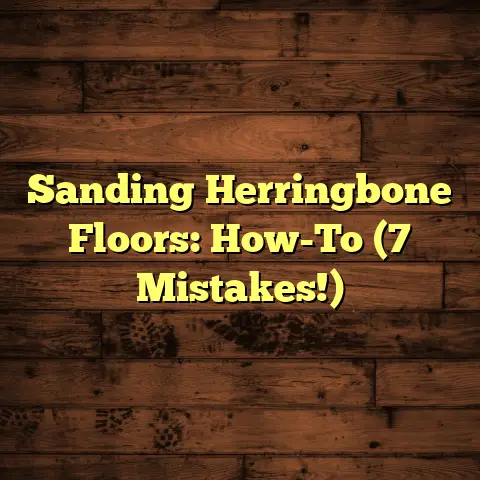Peel & Stick Tile: Pro Tips (7 Install Hacks!)
I’m so stoked you’re here!
As a flooring contractor with over 15 years in the game, I’ve seen it all.
From luxurious hardwood installs to budget-friendly vinyl solutions.
But today, we’re diving into something super accessible.
Something I’ve used myself in quick makeovers:
Peel and stick tile!
Remember that feeling? The excitement of planning a home makeover?
The anticipation of transforming a space into something truly you?
I get it!
I’ve been there countless times, both professionally and in my own home.
There’s something deeply satisfying about creating a space where memories are made, where families gather, and where you can truly be yourself.
And sometimes, the simplest
solutions can make the biggest
difference.
That’s where peel
and stick tile comes in!
Let’s unlock the secrets to a flawless, pro-level install. Ready? Let’s get to it!
Section 1: Understanding Peel & Stick Tiles
So, what are peel and stick tiles?
Essentially, they’re thin tiles.
Made from vinyl, or sometimes
even composite materials.
They have a pressure-sensitive
adhesive backing.
This is protected
by a paper or plastic film.
You
peel off the film, and stick the
tile to the floor.
Easy peasy, right?
The technology has come a long way!
Back in the day, peel and stick
was seen as a purely budget option.
But now?
You can find incredibly
realistic wood-look planks,
stylish stone patterns, and even
eye-catching geometric designs.
They’ve exploded in popularity.
Especially with DIYers and renters.
Why?
Let me break it down:
-
Ease of Installation: Seriously, it’s one of the simplest flooring options out there.
-
Affordability: Compared to traditional tile or hardwood, peel and stick is a budget-friendly winner.
Variety: As I mentioned, the styles are endless!
You can find something to match almost any aesthetic.
Section 2: Preparing for Installation
Alright, before you start peeling
and sticking, prep is key.
Trust me, a little upfront work
will save you headaches later.
First, measure your space accurately. Sounds obvious, but it’s crucial!
- Use a measuring tape to determine the length and width of the room.
- Multiply those numbers to get the square footage.
Add an extra 10% for waste.
Especially if you have a complex layout or plan on doing any diagonal cuts.Example: Let’s say your room is 10 feet by 12 feet.
10 x 12 = 120 square feet.
Add 10%: 120 x 0.10 = 12 square feet.
Total needed: 132 square feet.
Now, surface preparation! This is
where I see people often cut corners.
Don’t do it!
Clean, Clean, Clean: Vacuum thoroughly.
Then, wash the floor with a degreasing cleaner.
This removes dirt, grime, and anything that could interfere with the adhesive.Level the Playing Field: Peel and stick tiles need a smooth, level surface.
If you have any significant dips or bumps, you’ll need to address them.
Use a self-leveling compound to fill in low spots.
Here are some essential tools you’ll need:
- Measuring tape
- Utility knife with sharp blades
- Straight edge (a metal ruler or level works great)
- Cleaning supplies
- Self-leveling compound (if needed)
- Putty knife (for applying compound)
- A good pair of knee pads. Trust me, your knees will thank you!
Section 3: 7 Pro Installation Hacks for Peel & Stick Tiles
Okay, now for the juicy stuff!
These are the hacks I’ve learned
over the years that will take
your peel and stick game to the
next level.
Hack 1: Temperature Matters
Temperature plays a HUGE role in how well the adhesive sticks.
-
Optimal Conditions: Aim for a room temperature between 65°F and 85°F (18°C and 29°C).
Why? Cold temperatures can make the adhesive brittle and less effective.
Warm temperatures make it too soft.Pro Tip: Let the tiles acclimate to the room for at least 24 hours before installation.
This allows them to adjust to the temperature and humidity.
Hack 2: Using a Straight Edge for Cutting
Forget trying to freehand cuts!
A straight edge and a sharp utility
knife are your best friends.
The Method: Place the tile face up on a cutting surface.
Position the straight edge along the line you want to cut.
Score the tile firmly with the utility knife.
Repeat the scoring a few times, applying more pressure each time.
Then, snap the tile along the scored line.Sharp Blades are Key: Dull blades will tear the tile and create jagged edges.
Change your blade often!
Hack 3: Start from the Center
This is a classic tiling technique that applies to peel and stick as well.
-
Why? Starting from the center ensures a balanced look and prevents awkward slivers of tile along the edges of the room.
Finding the Center: Measure the length and width of the room.
Mark the halfway point on each wall.
Use a chalk line to connect the opposite marks.
The intersection of the chalk lines is the center of the room.Dry Fit: Before you start peeling and sticking, lay out a few rows of tiles from the center point to the walls.
This will give you a visual of how the layout will look and allow you to make adjustments if needed.
Hack 4: Utilize Spacing Guides
Even if your tiles are designed to be butted up against each other, using small spacers can create a more professional look.
Why? Spacers ensure consistent gaps between tiles.
This prevents the tiles from shifting over time and also allows for expansion and contraction due to temperature changes.-
What to Use: You can buy specialized tile spacers, or you can use something as simple as cardboard strips or popsicle sticks.
Hack 5: Use a Roller for Adhesion
Don’t just slap the tiles down
and hope for the best!
A roller
is essential for ensuring proper
adhesion and preventing air pockets.
The Process: After you’ve positioned the tile, peel back a small section of the backing.
Press the exposed adhesive onto the floor.
Slowly peel back the rest of the backing while pressing the tile firmly into place.
Use a hand roller to roll over the entire surface of the tile, applying even pressure.Types of Rollers: You can use a hand roller or a floor roller.
A floor roller is larger and covers more area, making it a good choice for larger rooms.
Hack 6: Grout Alternatives
Okay, this one’s a bit controversial,
but hear me out!
While peel and
stick tiles don’t require grout,
adding a grout alternative can
elevate the look and make them
appear more like traditional tile.
Why? Grout alternatives fill in the tiny gaps between the tiles, creating a seamless, finished look.
They also help to prevent dirt and moisture from getting underneath the tiles.What to Use: Flexible caulk is a great option.
It’s easy to apply and comes in a variety of colors.
Look for a caulk that is specifically designed for use with vinyl flooring.
Hack 7: Finishing Touches
Don’t underestimate the power
of finishing touches!
Baseboards
and trim can make a huge difference
in the overall look of your new
flooring.
Why? Baseboards and trim cover the edges of the flooring, creating a clean, polished look.
They also protect the walls from damage.Choosing the Right Trim: Select baseboards and trim that complement the style of your flooring and the overall aesthetic of the room.
Consider using quarter-round molding to cover any gaps between the flooring and the baseboards.
Section 4: Troubleshooting Common Issues
Even with the best preparation
and these pro hacks, sometimes
things go wrong.
Don’t panic!
Here are some common issues and
how to fix them:
Bubbles: If you notice bubbles underneath the tiles, use a utility knife to make a small slit in the bubble.
Press the air out and then roll over the area with a roller.Misalignment: If you accidentally misalign a tile, carefully peel it up and reposition it.
If the adhesive has lost its tack, you can use a small amount of spray adhesive to re-adhere it.Adhesive Failure: In rare cases, the adhesive may fail to stick.
This is usually due to improper surface preparation or extreme temperature fluctuations.
Clean the back of the tile and the floor surface with rubbing alcohol.
Apply a thin layer of spray adhesive to both surfaces and allow it to become tacky before re-adhering the tile.
Section 5: The Lasting Impact of Your Renovation
Remember that feeling of excitement we talked about at the beginning? You’re almost there!
Think about how your new flooring
will transform your space.
How
it will create a warm and inviting
atmosphere for family gatherings.
How it will be the backdrop for countless memories to come.
It’s not just about installing tiles. It’s about creating a home.
A place where you can truly be yourself, surrounded by the things you love.
Closing Thoughts
So, there you have it!
My top 7 pro hacks for installing
peel and stick tile.
I hope these tips have given you the confidence to tackle your own flooring project.
Now, I’d love to hear from you!
Have you ever installed peel and
stick tile?
What tips and tricks did you learn along the way?
Share your experiences in the comments below!
And remember, home is where the heart is. Happy renovating!





